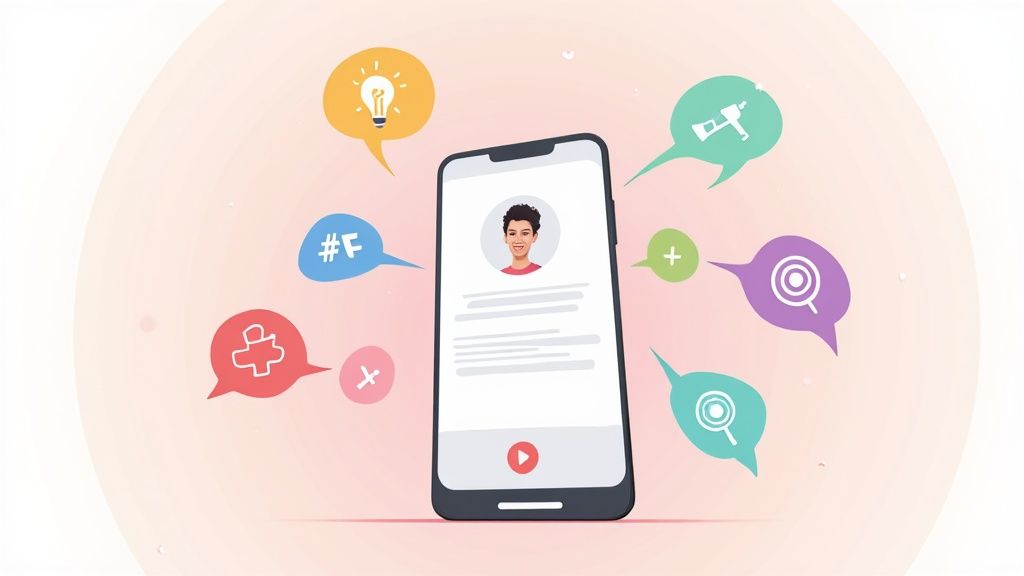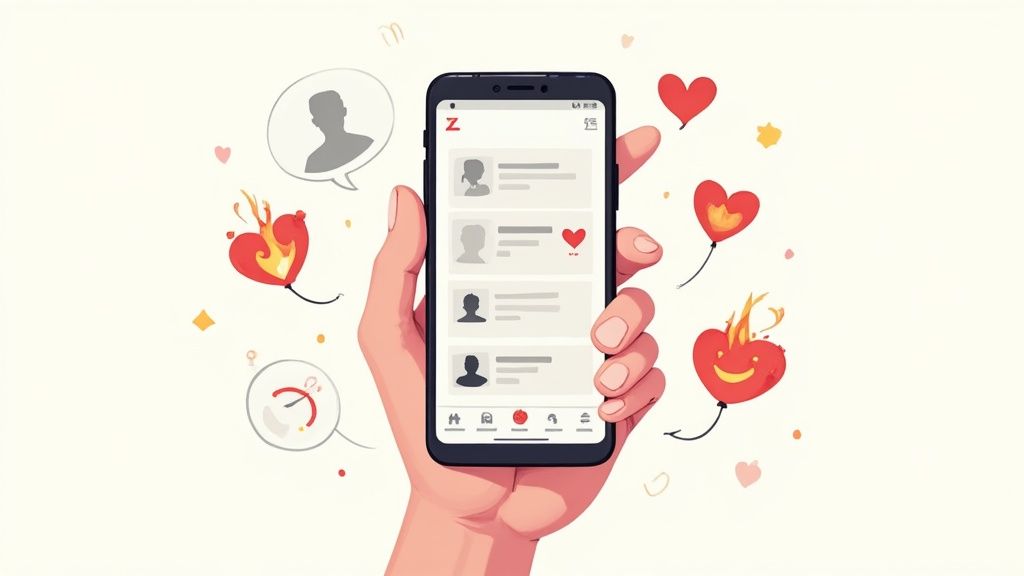How Do Tinder Likes Work? An Inside Look
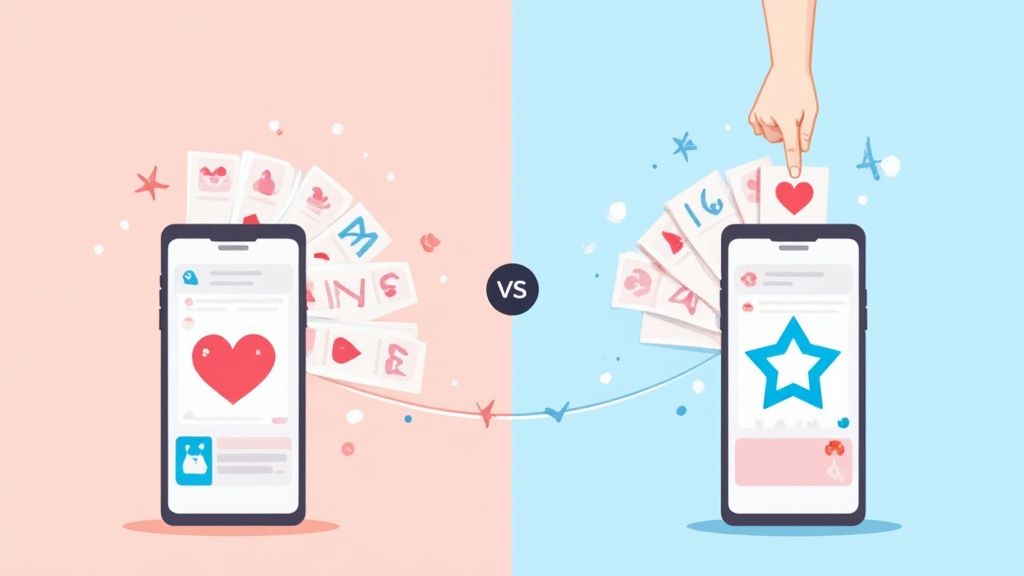
On Tinder, a "like" is basically you raising your hand and saying, "Hey, I'm interested." You do this by swiping right on someone's profile. Think of it as casting a vote for a potential connection—but here's the catch: nothing happens unless that person also votes for you. It’s only when two people mutually swipe right on each other that you get a match, which finally opens the door to start a conversation.
What Happens When You Swipe Right on Tinder
Swiping right is the core move on Tinder, but what's actually going on behind the curtain? When you swipe right on a profile, you're essentially telling the app's algorithm that you're interested in that person. Your profile then gets added to their stack of potential matches.
At first, this action is completely one-sided. The other person gets zero notification that you've liked them (unless you decide to use a special feature like a Super Like, but more on that later). Your profile simply joins the sea of other profiles they'll eventually swipe through. For them, nothing has changed—until they come across your profile and have to make their own call.
The Digital Handshake Process
I like to think of it as a digital handshake. For it to work, both people have to extend their hand. It’s a simple, two-part process.
Here’s a quick breakdown:
- Your Action: You find a profile you like and swipe right.
- Tinder's Role: The app logs your "like" and slides your profile into the other user's card stack. Don't assume it puts you right at the top, though.
- Their Action: Sooner or later, they'll see your profile while they're swiping.
- The Outcome: If they also swipe right on you, boom! It's a match. If they swipe left, your "like" just disappears into the digital ether, and no connection is made.
This simple mechanic has been the engine driving the app since day one. This visual gives you a perfect sense of how that single swipe works.
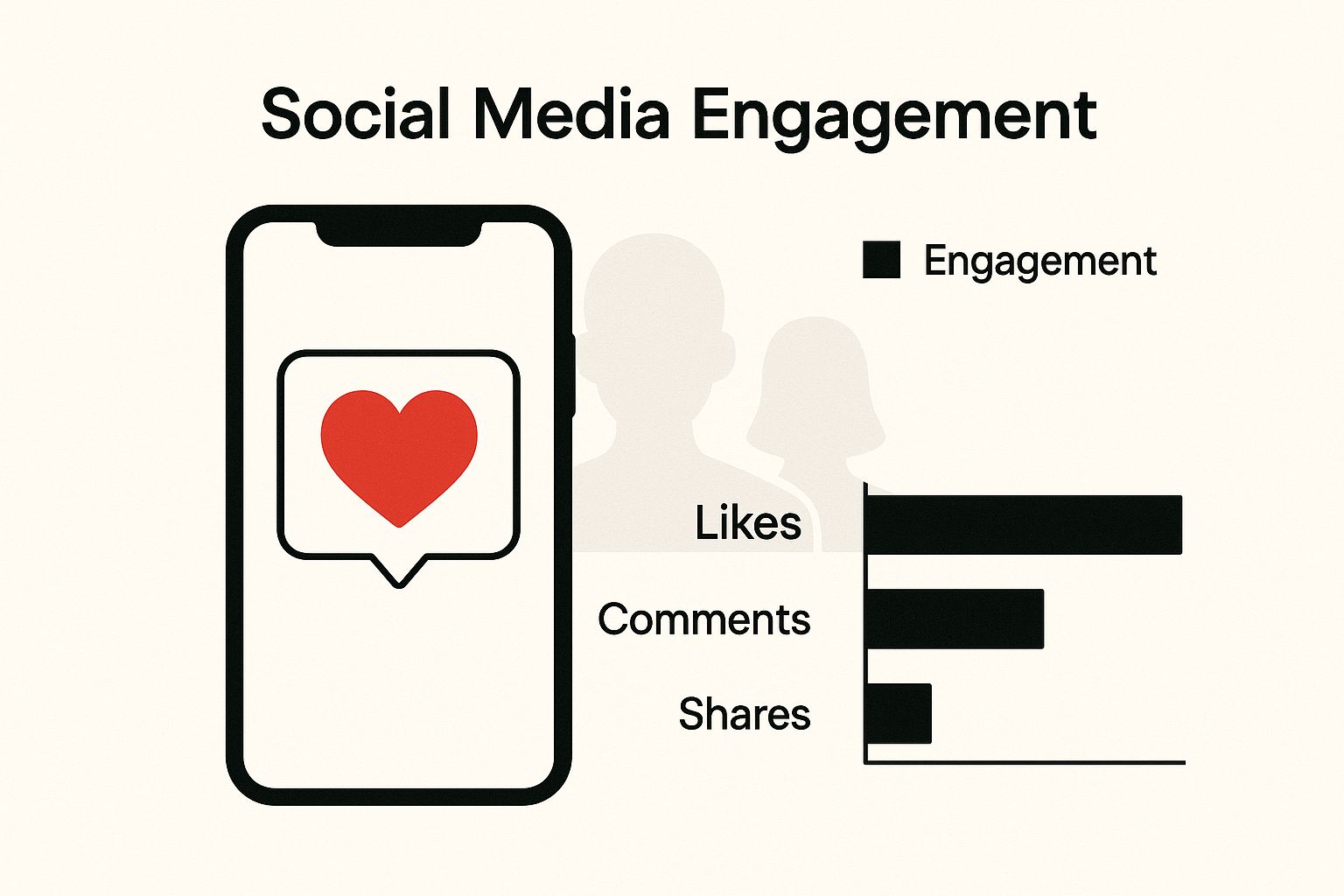
As the image shows, a "like" is just the first step—a potential connection that isn't guaranteed. It's a system that has scaled to an incredible degree. The simple swipe-right-to-like function now powers over 1.6 billion swipes daily, resulting in around 26 million matches across the globe every single day. If you're curious, you can explore more Tinder data to see just how massive the platform's reach is.
To make this crystal clear, let's quickly break down the difference between a 'like' and a 'match.'
Tinder Like vs Match A Quick Breakdown
| Action | What It Means | Requirement | Result |
|---|---|---|---|
| Like | You express interest in someone's profile. | Just your own right swipe. | Your profile is added to their swipe queue. |
| Match | A mutual connection is established. | Both you and the other person must swipe right. | A conversation can begin. |
The table really sums it up: a like is what you do, and a match is what you get when the interest is mutual.
Key Takeaway: A Tinder like isn’t a notification—it’s a possibility. It only becomes meaningful when that interest is returned, turning two separate right swipes into a real connection.
The Difference Between Free and Paid Likes
If you’ve ever settled in for a solid swiping session on Tinder, you’ve almost certainly run into that frustrating "You're out of likes" pop-up. That’s not a bug—it’s a deliberately designed feature of the free experience. Tinder puts a cap on how many right swipes you get in a 12-hour window.
This daily limit does two things for Tinder. First, it forces you to be a bit more thoughtful about who you swipe right on instead of just machine-gunning likes at every profile. Second, and more importantly for them, it creates a pretty big reason to pull out your credit card and upgrade to a paid plan. It's a core part of their business model, turning your desire for more matches into their revenue.
Unlocking Unlimited Likes with Premium Plans
This is exactly where Tinder’s subscription tiers—Plus, Gold, and Platinum—enter the picture. The single biggest perk they all share is unlimited likes. When that daily limit disappears, it completely changes how you can use the app. You can swipe for as long as you want without ever getting cut off.
But the paid plans offer more than just an endless supply of swipes; they supercharge the likes you do have. Tinder’s whole subscription model is built to get your profile seen by more people and make your likes more powerful. And it works. In 2024, Tinder had around 9.6 million subscribers, which shows just how many people think the advantages are worth paying for. A huge part of that appeal is getting to see who’s already liked you, letting you skip the guesswork and go straight for a guaranteed match. You can see a full breakdown of Tinder statistics that dive deeper into how its paid features drive its massive success.
The Big Picture: Think of the free version of Tinder as the free sample. It gives you a taste. The paid versions, on the other hand, give you the tools to be way more strategic. Unlimited likes let you cast a wider net, while seeing who likes you first makes every swipe more efficient.
The gap between the free and paid experience is pretty wide. Free users are stuck with a lot of guessing and waiting. Subscribers get more control and a ton more information. They can swipe endlessly and focus their energy only on people who have already shown interest. Learning how to leverage these tools is a huge part of winning the dating game, which is why figuring out how to succeed on Tinder often means knowing when an upgrade makes sense for you.
Ultimately, it all boils down to your own dating goals and how much time you're willing to sink into the app. The free version is perfectly fine for casual browsing. But if you're serious about maximizing your matches, the unlimited likes from a paid plan offer a clear and undeniable edge.
Using Super Likes and Priority Likes to Stand Out
In the absolute chaos that is the Tinder swipe deck, a standard right swipe can feel a bit like dropping a message in a bottle into the ocean. You send it off and just hope for the best.
To cut through all that noise, Tinder gives you a couple of special tools designed to make sure your profile actually gets seen. Think of it this way: a regular like is a quiet nod from across a crowded room. A Super Like is walking right up to someone and telling them they caught your eye. It’s a bold move, and it’s meant to grab their attention.
Then you have Priority Likes, which are like a VIP pass for your profile. This premium feature doesn't change how you like someone, but it has a huge impact on how fast they see you. Instead of your profile getting shuffled into the general deck, Priority Likes make sure you land near the very top of their swipe queue.

What a Super Like Actually Does
When you smash that blue star and send a Super Like, the other person sees your profile framed with a bright blue border. It’s an instant signal that you have a higher-than-average level of interest. This isn’t just a visual gimmick; it completely changes the dynamic of that first impression.
Suddenly, your profile isn't just another face in the crowd. It’s one that made a specific, deliberate choice to stand out from the rest.
This little visual cue can make a massive difference. Tinder's own data has shown that using a Super Like can seriously increase your chances of getting a match. In fact, they claim it can make you up to 3x more likely to get a right swipe in return. It screams confidence and genuine interest, which can be a very attractive combination.
The Strategic Advantage: A Super Like basically tells the other person, "Of all the profiles I've seen, yours really stood out." That small gesture can be just enough to spark their curiosity and get them to take a much closer look at your profile before they decide to swipe.
How Priority Likes Give You an Edge
If you're a Tinder Platinum subscriber, you get access to Priority Likes—a more subtle, but equally powerful, tool. They work behind the scenes to give your profile a serious algorithmic boost. Every single time you swipe right on someone, your like is automatically given precedence over any likes from non-Platinum users.
Imagine two people liking the same popular profile. The user with Priority Likes will have their profile shown to that person way sooner. In a super competitive environment where some users might see hundreds of profiles a day, being seen first is a game-changing advantage.
Here’s a quick breakdown of how these two features stack up:
| Feature | Primary Function | How It Works | Best For |
|---|---|---|---|
| Super Like | Grabs attention with a direct, visible signal. | Adds a blue star and border to your profile in their deck. | Making a powerful first impression on someone you're really interested in. |
| Priority Like | Increases your overall visibility across the board. | Pushes your profile higher in everyone's swipe queue. | Maximizing your match potential with every single person you swipe right on. |
At the end of the day, both features are built to solve the same core problem: getting noticed. A Super Like is a targeted, high-impact tool for a single profile you don't want to miss. Priority Likes, on the other hand, offer a consistent, passive boost to all your right swipes. Really understanding how Tinder likes work means knowing when to use these features to your advantage and turning a simple swipe into a calculated, strategic move.
How the Algorithm Shapes Your Tinder Experience
Every single swipe you make on Tinder is a breadcrumb. You’re leaving a trail of clues that teaches the app’s powerful algorithm exactly what you’re looking for. This invisible system is constantly humming in the background, deciding who sees your profile and whose profiles land in your stack.
Think of the Tinder algorithm as a super-attentive, data-obsessed matchmaker. Its core job is to predict successful pairs by watching how everyone behaves on the app. It's not just about how many people you like; it’s about the quality and pattern of those likes. This system is way more sophisticated than the old, simplistic "Elo score" everyone used to talk about.
Today’s algorithm is much more dynamic. Its main goal is to keep you happy and swiping by showing you people it genuinely thinks you’ll connect with.
Your Swiping Behavior Is Your Reputation
The way you swipe sends some pretty strong signals to the algorithm. It pays close attention to how selective you are. Are you actually looking at profiles, or are you just swiping right on everything and hoping for the best?
Mindlessly liking every profile you see is one of the biggest mistakes you can make. That kind of behavior tells the algorithm you aren't discerning, which can seriously tank your profile's visibility. It starts to think you might be a bot or just a low-quality user, so it stops showing you to as many people.
The Bottom Line: Selective swiping gets rewarded. When you're thoughtful about your right swipes, the algorithm sees you as a high-quality user. In return, it's more likely to show your profile to other desirable users who are also being selective.
The whole system is built on reciprocal interest. The algorithm learns from who likes you, who you like back, and whether those matches actually turn into conversations. Every interaction refines its understanding of your type. For a deeper dive, our guide on how the Tinder algorithm works breaks down the key factors that influence your profile's score and visibility.
Key Factors That Influence Your Visibility
A few key elements determine how often your profile gets shown around. The algorithm is constantly juggling these factors to curate the best possible experience for everyone.
- Profile Quality: This is non-negotiable. High-quality photos and a complete, engaging bio are your ticket to the game. The algorithm naturally favors profiles that look good and offer some real info, since they’re way more likely to get right swipes.
- User Activity: Are you an active user? The algorithm prioritizes people who log in frequently and actually use the app. If you ghost the app for weeks, your visibility will probably drop until you start swiping again.
- Recency: Tinder often gives a little boost to new users to get them started. In the same way, being recently active can also bump you up in other people’s queues.
Ultimately, your actions directly shape how Tinder presents you to the world. A well-crafted profile combined with thoughtful, active swiping tells the algorithm you’re a serious user, and it will reward you by putting you in front of more potential matches.
The Complete Journey of a Tinder Like
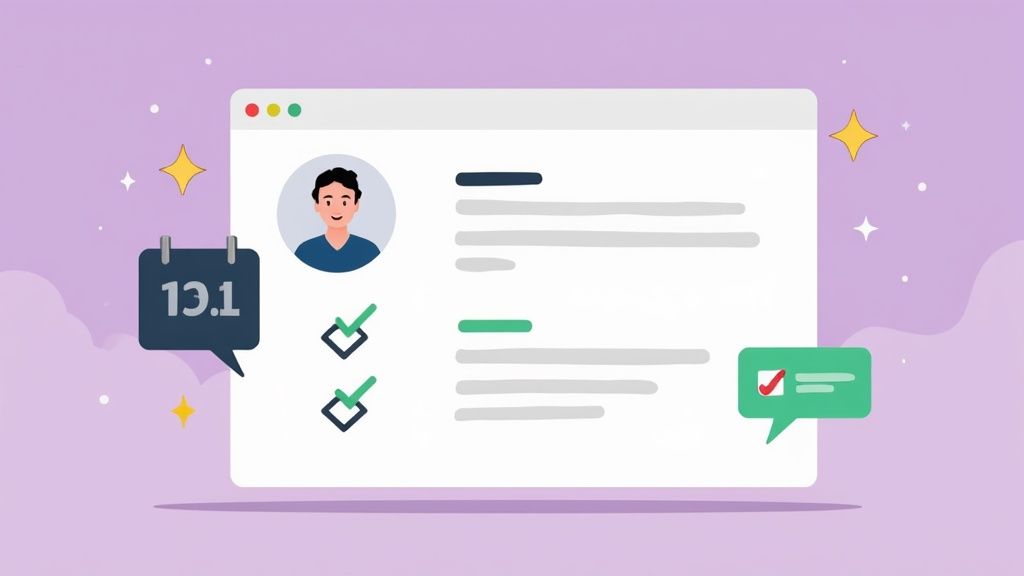
So, you’ve just swiped right on someone who caught your eye. What actually happens next? Think of your "like" as a message in a bottle. It enters a digital queue, where it sits patiently waiting for the other person to stumble upon your profile.
A question I get asked all the time is whether Tinder likes expire. The short answer is no. Your like will hang out in their queue indefinitely, just waiting for a verdict. It doesn't poof into thin air after 24 hours or lose its power over time. This is why you can sometimes get a match notification days—or even weeks—after you first swiped.
But what if the person you liked goes inactive or deletes their account? If they just stop using the app, your like simply continues to wait in their profile stack for their eventual return. If they delete their account for good, however, your like gets wiped out right along with it.
What Happens When Someone Likes You Back
This is where the magic happens. When someone you’ve already liked finally swipes right on you, it triggers an instant match. You both get that famous "It's a Match!" screen, and a new conversation thread immediately appears in your messages tab.
This is the moment your one-sided signal of interest becomes a real two-way connection. The whole process is designed to be a low-pressure way to show you’re interested without the fear of direct rejection. You only find out the outcome when it’s good news for both of you.
If you feel like you’re doing a lot of swiping but not much matching, it might be time to rethink your approach. For some practical advice, check out our guide on what to do if you are getting no likes on Tinder.
Using the Likes You Feature to Skip the Guesswork
For those with a Tinder Gold or Platinum subscription, the journey of a like looks completely different. These premium plans come with a killer feature called "Likes You," which is basically a cheat sheet for matching. Instead of swiping and hoping, you get a special grid showing you every single person who has already swiped right on you.
This feature totally changes the game from one of chance into one of choice. You can scroll through this list of admirers and instantly match with anyone you find interesting.
The Big Advantage: The "Likes You" grid removes all the guesswork. You can choose to match, pass, or ignore profiles, all with the full confidence that they’ve already given you the green light. It’s a massive time-saver.
Getting Past the Rumors: How Tinder Likes Really Work
The world of online dating is buzzing with advice, but a lot of it is just plain wrong. When it comes to something as basic as a Tinder like, you need to separate the myths from what actually gets you results. Let's clear the air and look at what's really going on behind the scenes.
One of the biggest myths floating around is that you should just swipe right on everyone to maximize your chances. This is a terrible idea. In reality, that strategy signals to the Tinder algorithm that you're not selective, which can seriously hurt your profile's visibility. It's about quality, not quantity.
Myth vs. Fact: What You Need to Know
Let's break down some of the most common beliefs so you can stop guessing and start swiping smarter.
Myth: You have to pay for Tinder to get any good matches.
Fact: Not true. While the paid subscriptions give you some cool perks like unlimited likes or seeing who already swiped right on you, the free version works just fine. A killer profile with great photos and a solid bio is what really moves the needle, whether you're paying or not.
Myth: Deleting your account and starting over is a magic trick for more matches.
Fact: You might get a small, temporary "new user" boost, but doing this over and over can actually get your account flagged by the algorithm. A much better long-term strategy is to just focus on improving your existing profile. Add new photos, tweak your bio—keep it fresh.
Key Insight: Think of every swipe as a vote. When you're thoughtful and selective, you're telling the algorithm that you're a high-quality user. In return, Tinder is more likely to show your profile to other active, desirable people.
Oops, I Swiped the Wrong Way—Now What?
We've all been there. You're in the zone, swiping away, and your thumb slips. You accidentally liked someone you had zero interest in. Panic sets in.
What happens next really depends on whether you're a free user or a subscriber. If you're using the free version, that like is out there for good. You can't take it back. Your only options are to hope they don't match with you or just unmatch them if they do.
But if you have a Tinder Plus, Gold, or Platinum subscription, you have a secret weapon: the Rewind feature. This little yellow arrow is your best friend for correcting mistakes. It lets you instantly undo your very last swipe, whether it was a like, a pass, or even a Super Like. It’s a safety net that makes sure all your likes are the ones you actually meant to send.
Your Top Tinder Likes Questions, Answered
Still got some questions about how Tinder likes really work? You're definitely not alone. The app can feel like a black box sometimes, but it doesn't have to be. Let's clear up the biggest head-scratchers once and for all.
How Many Likes Do You Get on Tinder for Free?
If you're using the free version of Tinder, you're working with a like limit. Every 12 hours, your likes get reset, but you don't get an infinite supply.
While Tinder keeps the official number under wraps, the general consensus is that you get somewhere between 50 to 100 likes in that 12-hour window. This isn't a hard and fast rule, though. The app's algorithm is smart, and it might adjust your limit based on things like your age, gender, and even how you swipe. If you're the type to just swipe right on everyone, you might find your limit shrinks.
The Takeaway: That like limit is there for a reason. It's designed to make free users think a bit more about their swipes and, of course, to gently nudge you toward a paid plan for unlimited action.
Can Someone See If I Liked Them?
Nope, not unless they've paid for a premium subscription. When you swipe right on someone using the free version, there's no notification, no alert, nothing. Your profile just gets quietly shuffled into their deck of potential matches.
The only way someone sees you've already liked them is if they're a Tinder Gold or Platinum subscriber. Those plans unlock a special "Likes You" grid, which is basically a gallery of everyone who's given them the green light. For everyone else, it’s a complete mystery until a match happens.
What Happens When You Run Out of Likes?
When you hit that daily limit, Tinder will pop up a screen letting you know you're out of gas for now. You won't be able to swipe right on anyone else until the timer resets.
From here, you have two simple choices:
- Wait it out: Just close the app for a bit. After the 12-hour cooldown, you'll have a fresh batch of likes ready to go.
- Upgrade your account: This is where Tinder will pitch you on subscribing to Tinder Plus, Gold, or Platinum to unlock unlimited likes and get right back to swiping.
Getting a handle on how likes work—both the limits and the features—is crucial for playing the game well. Whether you're making every swipe count on a free account or going all-in with a subscription, knowing these rules helps you build a smarter strategy.
Ready to stop wasting time and start getting more matches? With Auto-Swiper, you can automate your swiping on Tinder and other dating platforms, letting our smart extension handle the work while you focus on making real connections. Learn more and get started with Auto-Swiper today!

